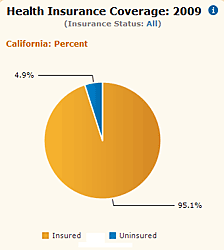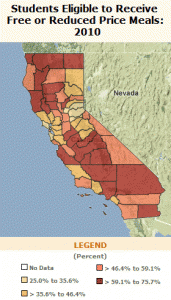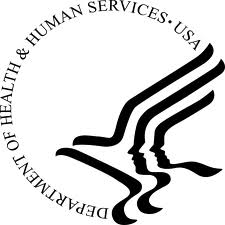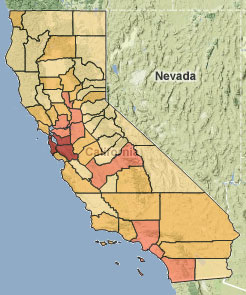Posts Tagged ‘Health Observances’
October is Domestic Violence Awareness Month
Domestic violence is an increasingly prevalent issue for California youth. According to the U.S. Department of Health and Human Services, in 30 percent to 60 percent of families that experience domestic violence, children also are abused (some estimates of this co-occurrence are even higher).
Additionally, children who witness domestic violence — even if they are not targets of the violence — tend to exhibit the same emotional, behavioral, and academic problems as abused children. Children raised in violent family environments also are at risk of becoming abusers or victims themselves during adolescence or adulthood.
Here in California, about 7% of 11th graders report dating violence, meaning they had been hit, slapped, punched, or otherwise hurt by a boyfriend/girlfriend in the past year, according to 2006-08 data.
See the reported percentage of youth dating violence for your county or school district >>
There were also a total of 166,343 calls for domestic violence related assistance in California in 2008.
Learn more about dating and domestic violence in California >>
Posted by kidsdata.org
Tags: Child Health Issues, Health Observances
This Week is National Primary Care Week
 This health observance began in 1994 in response to a shortage of primary care physicians. The goal is to bring awareness to the health care field of the interdisciplinary and comprehensive practice that primary care has to offer.
This health observance began in 1994 in response to a shortage of primary care physicians. The goal is to bring awareness to the health care field of the interdisciplinary and comprehensive practice that primary care has to offer.
This year’s observance celebrates Innovations in Primary Care.
Find a participating location for National Primary Care Week: http://primarycareprogress.org/programs/npcw.
Kidsdata.org offers data on several aspects of primary care for children, including health insurance, school health centers, and medical homes.
Posted by kidsdata.org
Tags: Health Observances
National School Lunch Week: A Focus on Healthful Eating
 This week is National School Lunch Week, supported by the National Education Association and the School Nutrition Association. This national health observance offers an opportunity to focus on making school-provided lunches as healthy as possible.
This week is National School Lunch Week, supported by the National Education Association and the School Nutrition Association. This national health observance offers an opportunity to focus on making school-provided lunches as healthy as possible.
For this year’s theme — “School Lunch- Let’s Grow Healthy” — schools are encouraged to follow a program to educate kids about locally grown produce and the benefit of eating lunch, in order to grow up strong and healthy.
Kidsdata.org includes data on eligibility in the Federal Free/Reduced Price School Meal Program. These data, from the California Department of Education, are available for counties and school districts.
In 2010, more than 3.4 million California public school students (56%) were eligible to receive free/reduced price meals. And, in nearly every county in California, that percentage increased from 2008-2010. See more local breakdowns>>
What’s happening in your school district? Visit kidsdata.org to find out>>
Posted by kidsdata.org
Tags: Health Observances
Today is National Child Health Day
 Monday, October 3rd, 2011, marks the 83rd annual National Child Health Day, an observance of child and maternal health sponsored by the Department of Health and Human Services.
Monday, October 3rd, 2011, marks the 83rd annual National Child Health Day, an observance of child and maternal health sponsored by the Department of Health and Human Services.
Last year, President Barack Obama acknowledged the observance with this proclamation:
The health and well being of a child is one of our most challenging, yet important, responsibilities, and we have an obligation to ensure that all our children can live, learn, and play in safe and healthy environments. On Child Health Day, we reaffirm the critical importance of the quality health care, nutritious foods, clean air and water, and safe communities our kids need to grow into strong and active adults.
Read the full proclamation>>
Kidsdata.org offers data and information on many topics related to this observance and President Obama’s proclamation:
See all topics on kidsdata.org>>
Posted by kidsdata.org
Tags: Health Observances
Health Observances for September: Cancer, Suicide Prevention, and More
 September is a busy month for health observances. Following is a partial list with accompanying data from kidsdata.org.
September is a busy month for health observances. Following is a partial list with accompanying data from kidsdata.org.
Fruits and Veggies- More Matters Month
National Childhood Obesity Awareness Month
- The percentage of California 5th and 7th graders at a healthy weight (69% for both in 2010) has held fairly steady over the past decade, while the percentage of 9th graders at a healthy weight improved slightly, from 65% in 2002 to 71% in 2010.
Childhood Cancer Awareness Month
- According to 2002-2006 data, leukemia was the most commonly diagnosed type of cancer in CA children ages 0-19, with a rate of 4.9 per 100,000.
- 16 of every 100,000 CA children were diagnosed with cancer, according to 2002-2006 data.
National Infant Mortality Awareness Month
- 5.2 of every 1,000 infants died before their first birthday in CA, according to 2005-2007 data.
National Alcohol and Drug Addiction Recovery Month
- Data from 2006-2008 show that a higher percentage of CA male vs. female 7th graders report that they don’t use drugs (64% vs. 52%), but by 11th grade, the opposite is true: a higher percentage of female vs. male 11th graders report that they don’t use drugs (71% vs. 67%).
National Suicide Prevention Week
- Overall, youth suicide rates in CA are trending downward. The state’s youth suicide rate in 2005-07 was 6.9 per 100,000 youth ages 15-24, substantially lower than the rate of 9.4 in 1995-97.
Posted by kidsdata.org
Tags: Health Observances
Health Observance Highlights Importance of Childhood Injury Prevention
National Child Injury Prevention Week begins this Thursday, Sept. 1. How many children suffer from injuries in your county? You can find out at kidsdata.org.
According to data recently updated on kidsdata.org, after a 7-year decline, the rate of hospitalizations for unintentional injuries in California has increased in recent years for children ages 1 to 4. In fact, the unintentional injury hospitalization rate declined for every other age group between 2007 and 2009 — 1-4-year-olds were the only age group for which rates increased.
These data are underscored by a recent American Academy of Pediatrics report about injuries from children accidentally falling out of windows, which found that children under age 4 were more likely to suffer head injuries and be hospitalized for their injuries than older children.
Organizations such as Safe Kids USA, the California Injury Prevention Network, and the CDC’s Youth Risk Behavior Surveillance System offer information and tips on keeping kids safe. If you know of other resources, please list them here.
Posted by kidsdata.org
Tags: Child Health Issues, Data Sources, Health Observances
This Week Is World Breastfeeding Week
It’s World Breastfeeding Week, and we’re celebrating by sharing updated breastfeeding data for California. Breast milk is widely acknowledged as the most complete form of nutrition for infants, and offers variety of benefits for infant health, growth, and development. Breastfeeding also offers multiple health advantages to mothers, including reducing breast and ovarian cancer risk. Increasing the proportion of children who are breastfed during the first year of life — as well as the proportion who are breastfed exclusively up to the age of three months — are important public health goals.
According to the California Department of Public Health, in 2009, 52% of infants in California were breastfed exclusively in the hospital after birth. Among counties, percentages of exclusive breastfeeding ranged widely from 14% to 86%. Find data for your county >>
Percentages also ranged among racial/ethnic groups; Caucasian/White infants had the highest exclusive breastfeeding percentages, while Hispanic/Latino and African American infants had the lowest.
Learn more about breastfeeding >>
Posted by kidsdata.org
Tags: Child Health Issues, Health Observances
Obama Targets Bullying of Gay Youth with June Proclamation
Earlier this month, President Obama again proclaimed June to be National Lesbian, Gay, Bisexual and Transgender Pride Month. In the announcement, Obama called out initiatives set forth to prevent bullying of gay youth:
My Administration is actively engaged with educators and community leaders across America to reduce violence and discrimination in schools. To help dispel the myth that bullying is a harmless or inevitable part of growing up, the First Lady and I hosted the first White House Conference on Bullying Prevention in March. Many senior Administration officials have also joined me in reaching out to LGBT youth who have been bullied by recording “It Gets Better” video messages to assure them they are not alone.
In California schools, more than 1 in 10 7th and 9th grade boys reported being bullied due to their sexual orientation, according to ’06-’08 data. Among girls, 10% of 7th-graders and 9% of 9th graders said the same. Find data for your school district>>
For more insights into these and other bullying data, read our October blog post to mark National Bullying Prevention Month. The president’s “It Gets Better” video is available on YouTube.
Posted by kidsdata.org
Tags: Child Health Initiatives, Child Health Issues, Health Observances
Spotlight on Asian American and Pacific Islander Children
 |
This map shows the Asian/Pacific Islander child population of California. The counties with the highest percentage of Asian/Pacific Islander children are in the Bay Area. |
In honor of Asian-Pacific American Heritage Month, we’re highlighting related data about this population of children in California. These data come from kidsdata.org, and if you know of other sources of data or information about Asian American or Pacific Islander kids, we encourage you to add those here.
- About 10% of California’s child population is Asian or Pacific Islander, just over 1 million children.
- In California, about 12% of Asian American children and 17% of Pacific Islander children are living below the federal poverty level, according to ’09 data.
- In ’06-’08, roughly 24% of Asian American and Pacific Islander 7th, 9th and 11th graders said they had been bullied at school at least once in the past year due to their race.
- The teen birth rate among Asian American/Pacific Islanders in California consistently has been lower than that of other racial/ethnic groups for which data are available, according to 1995-2007 data.
Visit kidsdata.org for a summary of data available for Asian American and Pacific Islander children in California, and to compare data across demographic groups.
Also see kidsdata.org’s Research & Links section, which offers key reports about these and other demographic groups.
Posted by kidsdata.org
Tags: Health Observances
March Awareness Campaigns: Breakfast, Diabetes, Inhalants
 Several important children’s health observances take place this month. Following are highlights, along with related data from kidsdata.org.
Several important children’s health observances take place this month. Following are highlights, along with related data from kidsdata.org.
National School Breakfast Week was March 7 – 11. In California, 2006-’08 data show that students in 7th grade are more likely than 9th and 11th graders to say they ate breakfast that morning. Among 7th and 9th graders, boys are more likely than girls to say that they ate breakfast that morning. These data also show that Asian American and Caucasian/White students were most likely to say they ate breakfast (66% and 65%, respectively), while African American (53%) and Latino students (55%) were least likely to report having eaten breakfast.
The American Diabetes Alert Day which took place March 22, challenges all Americans to explore their risk for developing type 2 diabetes by taking the proper preventive health tests. According to 2005-06 data, 1% of California children with special care needs have diabetes.
Inhalants Prevention Week is this week (March 20-26) and aims to increase understanding about the use and risks of inhalants. Although most 7th, 9th, and 11th graders in California in 2006-08 said they had never used an inhalant, 5.8% of 9th-grade girls and 4.9% of 9th-grade boys reported using an inhalant 4 or more times. Students who report feeling less connected to their school also have higher levels of inhalant use.
Posted by kidsdata.org
Tags: Health Observances


